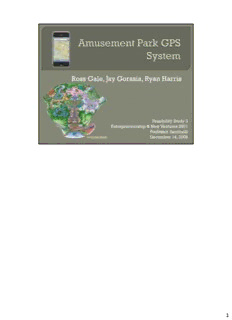
Amusement Park GPS System PDF
Preview Amusement Park GPS System
1 The original idea is a rental service for GPS-based devices at amusement parks. The key points are captured within the slide. In addition, the original idea memo is enclosed [See FirstIdeaMemo.docx] 2 We took a user-centric approach to this idea to reshape it into an opportunity. The approach involves understanding the user (the amusement park visitor) and generating from his/her needs as we have defined them. A solution that satisfies the need of a user is more likely to be one that we can support with a sound business model. Our approach will be detailed in the next few slides. The first step is to distill the original idea from the initial opportunity memo into key points. We thought the key points were: amusement parks, handheld and GPS. These points were written onto sticky notes. 3 Next, we independently considered each key point, and wrote down words and phrases we associate with the user’s experiences and that point on new sticky notes. For example, for amusement parks we generated: •Long lines •Waiting around •Families The purpose of this step is to get us more in tune with the users’ experience and prime our thoughts. Each of us generated on separate points and shared our results after we were done. 4 After that priming, we independently generated solutions to user needs based on our perception of user experiences. We have skipped a step here, of explicitly identifying the needs of the user based on detailed research. In a long term project we would put significant effort into interviewing and describing typical amusement park visitors. However, with only short time available, we considered our personal experiences at amusement parks and developed needs from our priming sessions. In solution generation, we thought first about fulfilling a need and then what type of solution would most appropriate solve that need (independent of feasibility). 5 We shared our solutions as a group, then grouped and arranged them. The groupings were based on solutions in a similar domain (e.g. time saving). Within each domain, we organized solutions based on their feasibility. We were more concerned with technological feasibility and social adoption of ideas. For instance, a brain scanner which scanned one’s brain and produced the perfect itinerary for the park visit is both technologically difficult and probably not socially acceptable. However, including an idea like a brain scanner indicates we believe amusement park goers would be interested in using there time efficiently. 6 We discussed and determined which group of solutions had the greatest potential benefit to the user. We knew we could not possibly pick all groups, as it would be difficult to form a coherent opportunity with such a wide array of ideas (mapping, personalized itinerary production, reservations, scavenger hunts, mobile applications, handheld device rentals, etc.). During this process, it was useful to look within each group to see where the different solutions could build off each other in order to form better ideas. The technologically infeasible ideas provided a springboard to shape feasible ideas into a more interesting, forward looking, or useful idea. 7 We captured the stronger solutions on a single sheet of paper, a Gallery Sketch. A gallery sketch captures the opportunity, the solutions we are proposing, and what needs of the user it would be fulfilling, with some focus on specific user interaction. Ideally we would produce several gallery sketches describing a variety of ideas so that we would have more options to choose between to go forward with. However, with our limited knowledge of users we produced only one reasonable gallery sketch, an idea which we feel improves upon the original opportunity memo. 8 The gallery sketch was then used as the basis for revising the original idea memo to incorporate new insights we developed through the reshaping process. The new idea memo is attached as a separate documents [See file IdeaMemoRevised.doc] 9 To recap, the user-centric reshaping process we went through started with the original idea. From there we thought about what the potential user experiences were. Then we generated solutions based on those experiences and their implicit needs. Next, we grouped and arranged ideas that were similar. We evaluated the different ideas, then developed simple gallery sketches. Finally, we used the gallery sketches to revise the original idea. The process we carried out is imperfect. We should learn about user experiences by talking to them, and not just by considering our own personal experiences. Secondly, we should have generated many more solutions, in order to have more gallery sketches to choose from. This suggests that we should iterate through this process after spending more time talking to more users. We will be able to revisit our assumptions and make sure they are consistent with the user data. 10
Description: